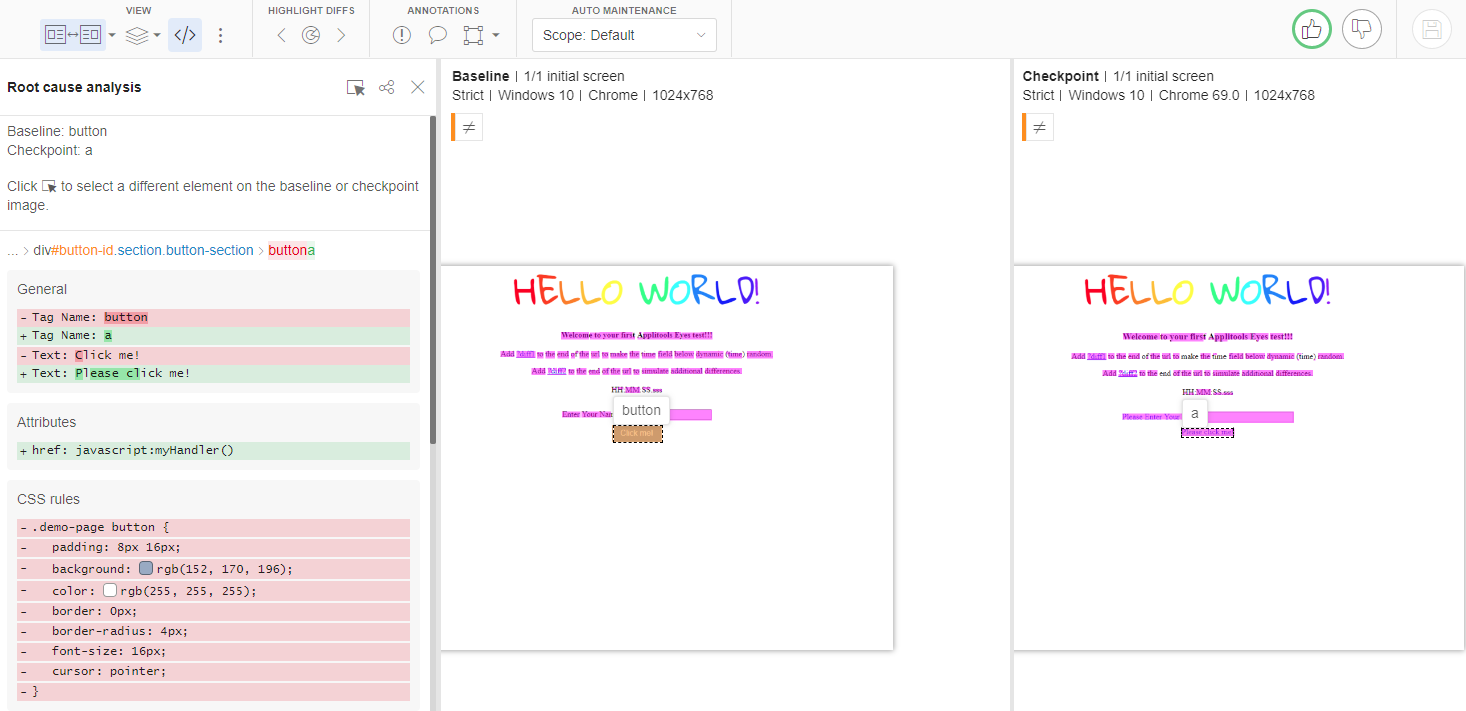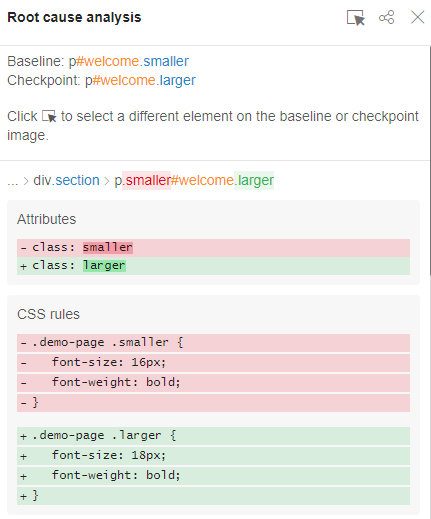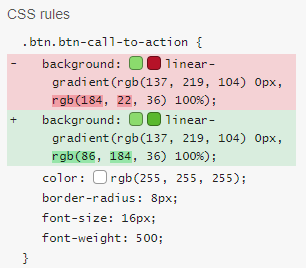Root Cause Analysis
Applitools Root Cause Analysis (RCA) provides insights into the causes of visual mismatches reported by Applitools Eyes. When a test is run, Eyes stores the DOM and CSS that generated the checkpoint along with the checkpoint image, and when a baseline is saved Eyes stores the DOM and CSS along with the updated baseline image.
In the Test Manager, when you view diffs between a baseline and checkpoint image, you can display differences between the checkpoint and baseline DOM and CSS information, and this can be helpful when trying to understand the cause of the visual difference. RCA is available in the Test editor, and on the Compare baseline page. For brevity we will refer to both of these tools as "the editor".

RCA is only available for DOM based web applications.
Viewing RCA
The editor displays RCA information when you click on a pink area that flags a visual difference in the checkpoint or baseline image panels (called here "diff"). The editor compares the DOM and CSS information stored with the images, and displays significant differences for any DOM elements that could impact the diff. RCA also allows you to manually select the elements whose DOM and CSS information will be compared. The following sections describe how to do this in detail.
Opening the RCA panel
Open the RCA panel by clicking on the Root cause analysis button in the toolbar.
![]()
If you see a message that indicates that DOM information is not available then proceed as described in the article Root cause analysis troubleshooting.
Viewing RCA by mismatch
To view the changes in the DOM elements and their CSS attributes that may have caused a diff :
- Click within the pink area indicating the diff, in either the checkpoint or the baseline image.
- The RCA panel displays the names of the baseline and checkpoint elements that overlay that area. It follows this with a list that consists of both these and other elements, that have DOM and CSS differences that may have caused the visual difference.
- If you click on a non-pink area, or if Eyes does not find relevant DOM elements, then an appropriate message is displayed in the RCA panel instead of the DOM and CSS information.
Viewing RCA by DOM element selection
In addition to having the editor identify the DOM element that may have caused a visual difference, you can also specify explicitly the DOM elements to be compared:
- Click on the select element control at the top of the DOM diff panel, or use the SHIFT + E key combination.
- Hover your mouse over the checkpoint or baseline image. As you do so, the editor highlights the bounding boxes of the element under the cursor. The editor highlight the content box in blue, the padding and border box in green and the margins in orange in the same way as is done in Chrome DevTools.
- When you click on the image, the editor highlights the current element and updates the RCA panel to reflect the differences between the newly selected element and the previously selected element in the other (baseline or checkpoint) image. The select element control is cleared . after you select the element, so to change the element, or select an element in the other window, click the control again.
The RCA panel
Initially the RCA panel displays a message that instructs you to click on a diff, i.e. on a pink area in the checkpoint or baseline images. After you have clicked a diff, the RCA panel displays a list of elements that may have impacted that diff. If you manually selected a checkpoint and/or baseline element, then the list of elements reflect the differences between the currently selected elements.
At the top of the panel you can see the tag names of the selected elements in the baseline and checkpoint and any ID and class information that is available:
The example above shows that both elements have a <p> tag and an ID of welcome. The baseline has a class of smaller and the checkpoint a class of larger.Note that the tag name is colored black, the ID is colored orange, and the class is colored blue. You can:
- Click on the element names to display the image for that element, zoomed in to that element. See Zoom in on the compared element for details.
- Hover over the name to see the full DOM path of the element and access a control to copy it to your copy/paste buffer, see Copying RCA information below.
Underneath the elements tag name, you can see a list of elements, that have DOM or CSS differences that may have impacted the selected diff. The editor displays:
- The checkpoint DOM path and any differences between that path and the path of the corresponding baseline element.
- A list of one or more DOM and CSS differences.

The color of the text or the text background indicates the differences between the checkpoint and the baseline. Values that are colored green were added in the checkpoint DOM with respect to the baseline DOM, and values colored red were removed from the checkpoint DOM. In some cases, values are displayed even though they are identical in the baseline and checkpoint (e.g. the element path, box dimensions, CSS Rules) - in these cases the values are not colored.
Types of DOM Differences
The following are examples of the types of difference displayed by the Eyes Test Manager:
Tag changes
The element tag has changed from <button> in the baseline (red) to an <a> in the checkpoint (green). Unchanged IDs and classes are drawn in orange.
Attribute changes
In this example the class "smaller" in the baseline DOM has been replaced by the class "larger" in the checkpoint DOM. You can also see this in the attributes box, where the "-" in the red box indicates that the class was in the baseline and was removed from the checkpoint, and the "+" in the green box indicates that the "larger" class was added in the checkpoint. You can also see this in the element path where "smaller" is colored in red and crossed out and larger is colored green.
Bounding box changes
In the example above, the left coordinate is 854.5 in the baseline and 864.5 in the checkpoint, the top coordinate (17) is identical in both DOMs and the width and height are different (121.5 x 50 in the baseline, 111.5 x 40 in the checkpoint).
CSS property changes

In this example, the RCA panel indicates that the CSS background property in a CSS rule related to the selected element has changed. Note that when displaying CSS rules differences, the editor displays all the properties of the rule. The properties that are different are shaded in red or green, and the properties that are identical are shown unshaded.
Textual change
In this case, the text node of the element has changed (and become more polite !).
Zoom in on the compared element
If you click on the selected element name, at the top of the RCA panel, then the editor switches to the appropriate image window if it is not visible, and adjusts the zoom so that the element fills the window.
Identifying the elements being compared
To see the bounding boxes of DOM elements in the list, overlaid on the images, hover the mouse over an element in the list of DOM differences, as you do so, the editor overlays the checkpoint and baseline images with the bounding boxes of the element pointed to in the list.
Copying RCA information
To obtain a URL that will reproduce the RCA information currently shown in the editor, click on the Share RCA control. The editor copies the URL to your clipboard and you can paste it anywhere convenient (e.g. a comment, issue, or email). When this URL is copied into the browser address bar, the relevant editor will open, displaying the step, selected elements and RCA information that were displayed when the URL was generated.
If you hover over the checkpoint or baseline element name at the top of the panel the full path name of the element will be displayed, and a copy control will appear to the right of the name:
To copy the text of the full path of the element to the clipboard, click the icon, you can then paste it into the editor comment or issue report or copy it to some other application such other an e-mail.
Close RCA panel
You can close the RCA panel by clicking on the button at the top of the RCA panel, by clicking on the Show RCA button toolbar, or by using the I shortcut key.
Troubleshooting
Some reasons why DOM information may not be available are:
- The SDK used to capture the checkpoint or baseline image does not use DOM (for example the images SDK). For a list of SDKs that support RCA see the section below SDKs that support RCA
- The test was run on an old version of an SDK before support for RCA was added. In this case update your SDK, to the latest version, rerun the test and force save the baseline as described in the next section.
- The test was run on an updated SDK that supports RCA, but the baseline was captured on a previous version of the SDK that did not support RCA, in this case you only need to force save your baseline as described in the next section.
- The SDK used to capture the baseline or the checkpoint was configured to not send the DOM. Enable sending the DOM using the command described in the table below SDKs that support RCA, then rerun the test. If the RCA information is missing for the baseline then force save your baseline as described in the next section.
Forcing a save on the baseline
Eyes only saves information to the baseline for new tests or if you explicitly accept and save a test or step. This section explains how to easily force save the DOM information for steps whose checkpoint matches the baseline.
Note that force saving the baseline also overwrites the baseline images with the checkpoint images of the saved test run. Only force save steps and tests whose results are acceptable as baseline images in future runs.
To do a forced save, take the following steps:
- Switch to the Test results page, Batch step details view.
- Select the filter More filters control, Step status option, and click the Matching checkbox.
- Close the filter dialog by clicking outside of the dialog.
- Accept each test whose results is acceptable as a baseline image using the button on the step thumbnail. If you are sure that all the displayed steps are valid for use as a baseline, you can also use the Accept all control on the top tool bar
- Finally, click on the save button so that the changes will saved to the baseline.